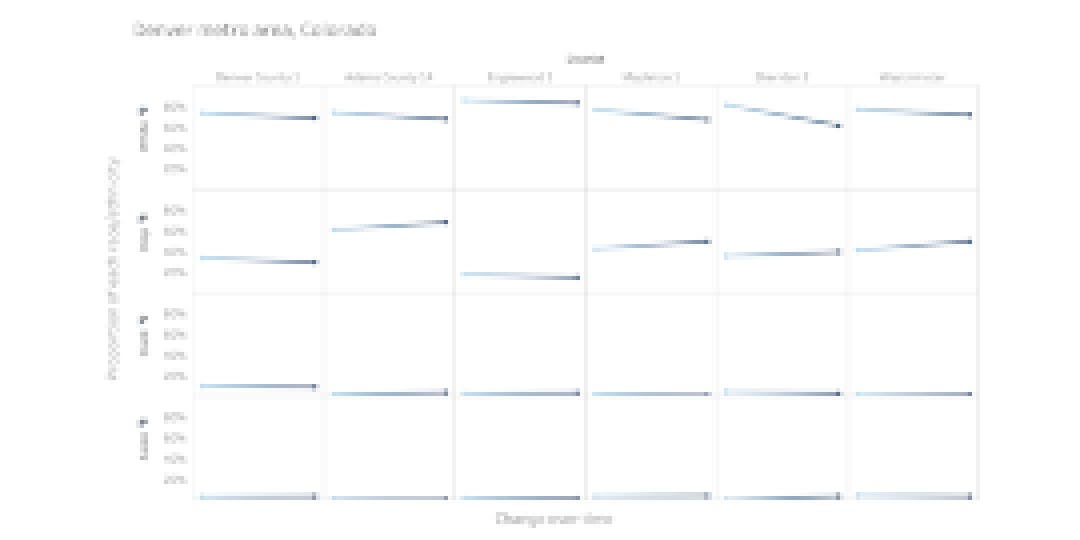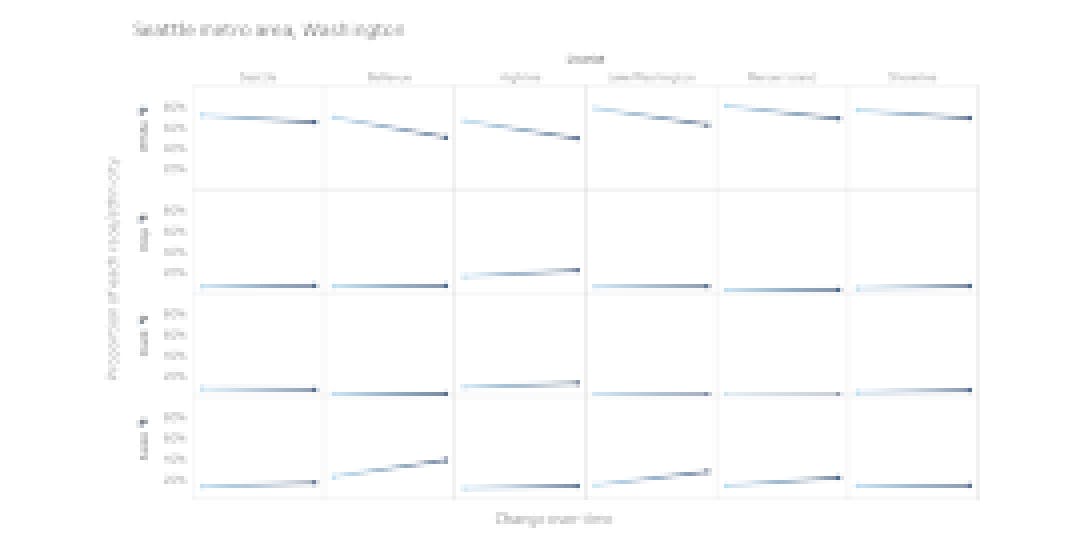Education researchers have long kept an eye on the changing demographics of public schools, some looking at the potential for those shifts to shepherd in inequity as ethnic groups migrate or fluctuate in size.
As the number of Hispanic students grows, for instance, the education landscape is adapting to meet their particular needs, as well — be it more representation in children’s books or busing a mobile preschool to kids in rural areas.
With the release of new data from the American Community Survey, EdSurge decided to take a look at demographic shifts in the school districts of five fast-growing areas around the U.S. to see how their communities have changed. The chart compares racial and ethnic makeup of the residents within each school district (not only students) from 2009 to 2021.
We selected this timeframe because each year actually represents the tailend of five-year data estimates, with data gathered from 2005-2009 and the newest from 2017-2021. Utilizing five-year estimates rather than year-by-year survey data is more reliable, according to the U.S. Census Bureau.
We also chatted with a few experts who added useful context to the numbers: how one school district has responded to its evolving demographics and what implications the changes have for students who are learning English as their second language.
We found that over that time, the school districts we looked at are generally experiencing a decrease in white residents while their number of Hispanic residents ticks up to varying degrees. That aligns with national student population trends documented by federal education statistics.

Denver
Six Denver-area districts showed the same trends more or less, with falling proportions of white residents. Denver Public Schools, however, also lost some of its share of Hispanic residents, while most other districts made gains in that demographic.
The region overall is still trying to recover from enrollment drops that started in the fall of 2020, the first full school year following the COVID-19 pandemic’s start.
An investigation by Chalkbeat Colorado found that the reasons for enrollment declines varied by district and were caused by a combination of issues: high housing costs pushing families farther from the metro area, charter school competition and simply fewer children being born.

Charlotte
In Charlotte, North Carolina, the school districts have been seeing a decline in white residents with slight increase in the proportion of Hispanic, Black and Asian residents.
The state is giving school districts millions in funding to find the roughly 12,000 students who haven’t been to school since the pandemic started, while charter and private schools in the area are seeing a boom in enrollment.

Austin
Nestled in the Texas Hill Country, Austin has been growing at breakneck speed for the past decade, according to the city’s demographer. That’s in large part thanks to the influx of tech and finance jobs that, while causing salaries and home values to skyrocket, are pricing Hispanic and Black families out of the city.
Austin Independent School District has seen a slight uptick of white and Asian residents since 2009, while the proportion of Hispanic and Black residents has fallen slightly. Neighboring school districts generally show the opposite trend between Hispanic and white residents, with increasing proportions of Hispanic residents and falling proportions of white residents.
Small-town districts Bastrop and Lockheart both saw double-digit increases — 19 percent and 14 percent, respectively — in their Latino populations.

Salt Lake City
In Utah, the Salt Lake City area is facing similar gradual changes with small decreases in white residents and slight increases in Hispanic residents. Districts in the area are weighing school closures as enrollment takes an overall decline as the growth of the school-aged child population slows.

Seattle
The shifts appear more pronounced around Seattle, where school districts are seeing double-digit drops in their proportion of white residents and modest increases in Hispanic residents. Some school districts are quickly gaining Asian residents. In nearby Bellevue, the proportion of Asian residents increased by 16 percentage points from 2009 to 2021.
Like districts in Utah, the Seattle Public Schools Board is weighing campus closures in response to an enrollment drop that started when COVID-19 forced schools to go virtual.
Catherine Carbone Rogers, chief communications officer for Highline School District, says demographic changes in the community reflect shifts that have been happening in its schools over the past 20 years.
The district, which serves roughly 18,000 students, has seen a sharp decline in white residents — about 17 percent — over the past decade alone, while the number of Hispanic, Black and Asian residents has slowly grown.
Rogers says over time, the district has responded to the changes by creating and expanding dual language immersion education, hiring bilingual staff to serve as “family liaisons” and providing professional development to teachers on culturally responsive teaching. That’s in addition to changes based not on demographics but on best practices and research on teaching that emerged during that same time period.
“That is just scratching the surface,” Rogers says. “All students from all backgrounds have strengths and needs. We ask teachers to recognize and focus on the assets that each child brings and not look at some children as ‘challenging’ or ‘in need’ because of their background.”
What About English Learners?
School districts in these areas, to varying degrees, saw increases in Hispanic residents. That includes the smaller, more rural districts. And while Hispanic students are not necessarily English learners, those who are can come up against barriers to learning as schools in changing areas adjust to their needs.
This can be particularly tough for English learners in rural areas, says Leslie Villegas, a senior policy analyst at education think tank New America.
Roughly 500,000 English learners live in rural areas, according to a National Center for Education Statistics estimate, with less property wealth also meaning less school funding.
“You're not going to be able to staff up or find qualified teachers if you don’t have the financial resources to do so,” Villegas says, “so that’s a huge barrier to being able to adapt even if they wanted to. Even if they had the best intentions, you still need the money to provide those services to those students.”
Those resources include bilingual teachers, professional development for staff and the ability to communicate with parents, she adds.
“It’s about making sure educators are prepared to teach them both content and language, because it’s two things at once,” Villegas says. “If they don’t have the capacity to talk to the families in the language that they know, that’s a huge barrier to their education, as well.”


